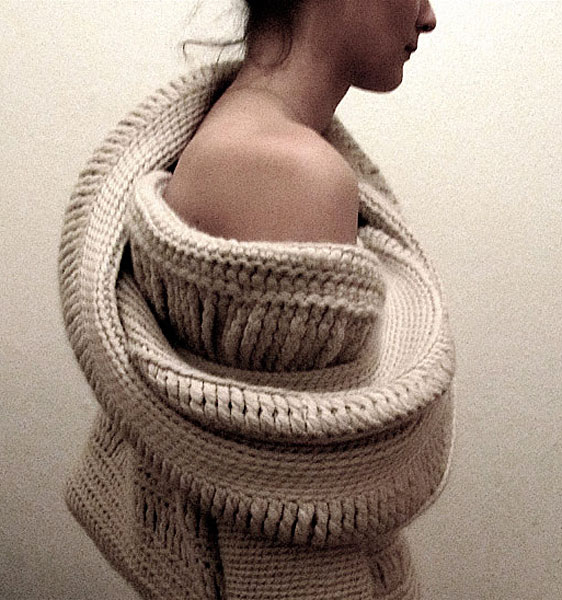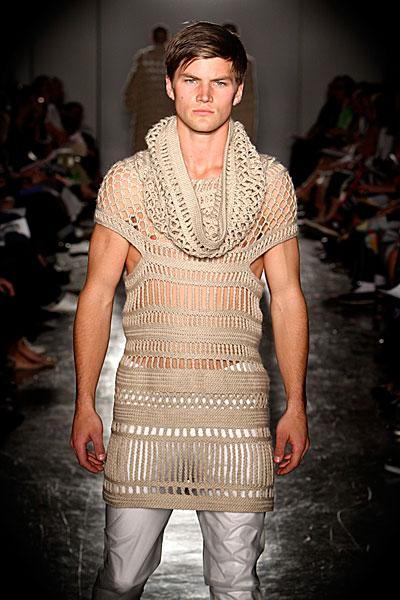Richard Price interviews knitwear designer Jillian Carrozza




Jillian Carrozza
Richard Price interviews knitwear designer Jillian Carrozza
RP: Where did you study, and why did you choose to study there?
JC: Mt. San Antonio College because I wanted to learn to sew before I left Los Angeles. The Fashion Institute of Technology because I wanted to learn everything, and to learn it in New York. Central Saint Martins College of Art and Design because it was my alibi for following a lover to London.
RP: What got you interested in knitwear? And what made you stick with it?
JC: My tailoring professor at FIT described tailors to me as ‘a dime a dozen’. He made knitting out to be an every-day exoticism, in pointing out that so many people wear knitwear, but so few pursue it in design. So, I specialised in knitwear in my final term at the institute and fell in love with this new discipline that allowed for total design control.
RP: You’ve recently graduated, what were the ideas and influences of your graduate collection?
JC: My graduate collection consummates my nine years of formal fashion training, thus it expresses many personal tastes and enumerated influences that have brewed and stewed in my psyche since childhood. On a tangible level, I am particularly enamoured with ancient and Baroque sculpture and architecture as well as 1930s photography and surrealism.
RP: Do you think it is important to preserve knitwear as a craft for future generations?
JC: I do not imagine that ‘preserving’ knitwear will be of any good – knitwear must be passed on with the intention for innovation and for the exploration of it as a general medium. Continue creating, not just replicating.RP: If you didn’t do knitwear, what would you do?
JC: I am sure creativity will always hold me captive, whether entangled in yarns and hooks or papers and pencils.RP: How much of your own feelings and personality do you feel come into your work?JC: 100%.
RP: Is there any particular artist, designer, or actor that you identify with in terms of your work?JC: I’ve been nestling into the work of Jean Cocteau, Lee Miller, Man Ray, George Hurrell, Eyvind Earle, Gil Elvgren, Diane Arbus, Grayson Perry, and Tracey Emin lately.
RP: What does fashion mean to you?
JC: Fashion is a business.
RP: Does this come across in your work, if so how?
JC: You’re going to have to help me on that one.
RP: What techniques/crafts/machines do you use in your work?
JC: For my graduate collection, all pieces were entirely crocheted by hand and styled with PVC and perspex.
RP: Which is better, knit, crochet, or machine knit?
JC: Each technique enjoys its own glories.
RP: Do you have a message you would like to send out to the Guild members?
JC: Yes. There are two very special women who were absolutely indispensable in completing my graduate collection:
- Nic Wyborn offered unprecedented generosity of heart and hands in crocheting the largest piece in the collection, the floor length coat. She is a woman of incredibly rare tenacity and craftsmanship. Nic dedicated a month of her life to helping me and I am forever indebted to her.
- Zoe Ann Plumb delighted me with her irrepressible enthusiasm and zeal for not just my own work, but for all yarn-related endeavours. Zoe’s effervescence was as valuable as her precision in contributing to the cascading curls of my collection.
- I also must give special thanks to Tracy Darby, who came to my rescue after a plea for help on Ravelry. I have never seen such effortless expertise and insouciant speed in crochet.
- I should also like to thank Richard Price for introducing me to the wonderful members of the Guild (for helping to rally the troops!)
From the bottom of my heart, I thank you all until the end of time!

